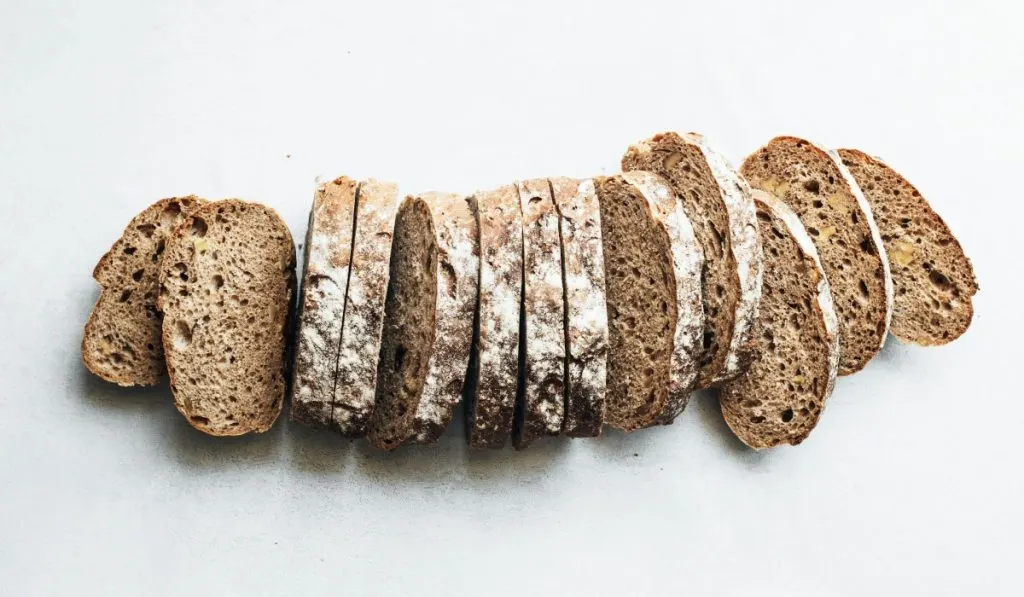
Have you ever wondered why, despite trying various diets, you can’t seem to feel full or energized? The solution might be simpler than you think. High-Fiber Sourdough Bread is here to revolutionize your eating habits, offering a tasty, nutritious way to improve your health. In this article, we’ll delve into the benefits of this incredible bread, why it stands out from other bread types, and how you can easily incorporate it into your daily diet.
TL;DR:
- High-Fiber Sourdough Bread helps with digestion and keeps you full longer.
- It has a lower glycemic index, making it a healthier option for blood sugar control.
- Easy to make at home with just a few ingredients.
- Offers a unique, tangy flavor that enhances any meal.
- Provides a myriad of health benefits from improved gut health to better heart health.
Why High-Fiber Sourdough Bread Is a Game Changer
For many Americans, bread is a staple. But not all bread is created equal. High-Fiber Sourdough Bread is not just any bread—it’s a powerhouse of nutrients and flavor. This bread combines the ancient art of sourdough fermentation with the modern need for high-fiber diets, making it a perfect addition to any meal. Whether you’re looking to improve your gut health, control your blood sugar, or simply enjoy a delicious slice, this bread has got you covered.
The Nutritional Benefits of High-Fiber Sourdough Bread
High-Fiber Sourdough Bread is packed with nutrients that are essential for a balanced diet:
Dietary Fiber:
- High-Fiber Sourdough Bread contains a significant amount of dietary fiber, which plays a crucial role in maintaining a healthy digestive system. Fiber helps to regulate bowel movements, prevent constipation, and promote overall gut health. Moreover, it helps you feel fuller for longer periods, which can aid in weight management by reducing the likelihood of overeating.
Probiotics:
- The unique fermentation process used in making sourdough bread results in the creation of probiotics. These beneficial bacteria are essential for maintaining a healthy gut microbiome. A balanced gut microbiome can improve digestion, boost the immune system, and enhance nutrient absorption. Regular consumption of probiotic-rich foods like High-Fiber Sourdough Bread can contribute to overall gastrointestinal health.
Low Glycemic Index:
- High-Fiber Sourdough Bread has a lower glycemic index compared to many other types of bread. This means it causes a slower, more gradual increase in blood sugar levels after eating. For individuals with diabetes or those trying to manage their blood sugar levels, this bread is an excellent choice. The slow release of glucose helps to maintain energy levels and reduce the risk of blood sugar spikes and crashes.
Vitamins and Minerals:
- This bread is a powerhouse of essential vitamins and minerals. It is particularly rich in B vitamins, which are vital for energy production, brain function, and cell metabolism. Iron, another key nutrient found in High-Fiber Sourdough Bread, is essential for the production of hemoglobin and myoglobin, proteins that carry oxygen in the blood and muscles. Additionally, magnesium, present in significant amounts, supports muscle and nerve function, regulates blood pressure, and contributes to bone health.
By incorporating High-Fiber Sourdough Bread into your diet, you can enjoy these nutritional benefits while savoring the delicious, tangy flavor that sets sourdough apart from other breads.
Audience Benefits: Why You Should Switch to High-Fiber Sourdough Bread
Imagine enjoying a slice of bread that not only tastes amazing but also helps you stay healthy. High-Fiber Sourdough Bread offers several benefits that can significantly improve your overall well-being:
Improved Digestion:
- The high fiber content in High-Fiber Sourdough Bread plays a pivotal role in promoting healthy digestion. Fiber adds bulk to the stool, making it easier to pass and thereby preventing constipation. It also helps maintain a healthy balance of gut bacteria, which is crucial for efficient digestion and absorption of nutrients. Regular consumption of this bread can lead to more consistent bowel movements and a healthier digestive tract.
Weight Management:
- One of the key benefits of High-Fiber Sourdough Bread is its ability to keep you feeling fuller for longer periods. This is due to the high fiber content, which slows down the digestion process and provides a sustained release of energy. By keeping hunger pangs at bay, this bread can help in controlling portion sizes and reducing the tendency to snack between meals. Consequently, it can be an effective tool in managing weight and supporting healthy eating habits.
Enhanced Flavor:
- The unique tangy taste of High-Fiber Sourdough Bread is a delightful departure from the bland flavors of many conventional breads. This distinctive flavor is a result of the natural fermentation process, which not only enhances taste but also breaks down gluten, making it easier to digest. The tanginess pairs well with a variety of toppings, from savory to sweet, adding an extra layer of enjoyment to your meals.
Additional Health Benefits:
- Improved Blood Sugar Control: The low glycemic index of High-Fiber Sourdough Bread means it has a minimal impact on blood sugar levels. This is particularly beneficial for individuals with diabetes or those at risk of developing the condition. By providing a slow and steady release of glucose into the bloodstream, it helps maintain stable energy levels and reduces the risk of blood sugar spikes.
- Heart Health: The combination of fiber, probiotics, and essential nutrients like magnesium and potassium found in High-Fiber Sourdough Bread contributes to better heart health. Fiber helps to lower cholesterol levels, while magnesium and potassium play roles in maintaining healthy blood pressure and heart function.
- Enhanced Nutrient Absorption: The fermentation process involved in making sourdough bread breaks down phytic acid, a compound found in grains that can inhibit the absorption of minerals. This makes the nutrients in High-Fiber Sourdough Bread more bioavailable, meaning your body can absorb and utilize them more effectively.
By switching to High-Fiber Sourdough Bread, you can enjoy these numerous health benefits while indulging in a delicious and satisfying food. Whether you’re looking to improve your digestion, manage your weight, or simply enjoy a tastier slice of bread, High-Fiber Sourdough Bread is a nutritious choice that can enhance your diet and overall health.
How to Make High-Fiber Sourdough Bread at Home
Making it at home is easier than you might think. Here’s a simple recipe to get you started:
Ingredients:
- 2 cups whole wheat flour
- 1 cup water
- 1 tsp salt
- 1/2 cup sourdough starter
Preparation:
- In a large bowl, mix the whole wheat flour, water, salt, and sourdough starter until a dough forms.
- Knead the dough for about 10 minutes until it becomes smooth and elastic.
- Place the dough in a lightly oiled bowl, cover it with a damp cloth, and let it ferment at room temperature for 8-12 hours, or until it has doubled in size.
- Preheat your oven to 450°F (230°C). Shape the dough into a loaf, place it on a baking sheet, and bake for 30-35 minutes, or until the crust is golden brown and the loaf sounds hollow when tapped.
Tips:
- Use whole grains for maximum fiber content.
- Ensure your sourdough starter is active and bubbly for the best results. Feed it regularly to keep it strong and ready for baking.
Enjoy your homemade bread as a nutritious addition to any meal!
Expert Tips
As an experienced journalist, here are some insider tips:
- Use Fresh Ingredients: Fresh, high-quality ingredients make a significant difference in the taste and texture of your bread.
- Patience is Key: The fermentation process takes time, but the health benefits and flavor are well worth the wait.
- Experiment with Add-Ins: Try adding seeds, nuts, or dried fruits to your dough for added flavor and nutritional benefits.
Common Myths About Sourdough Bread
There are several myths surrounding sourdough bread that need to be debunked:
- Myth: Sourdough bread is too complicated to make at home.
- Fact: With a little practice, anyone can master the art of sourdough baking.
- Myth: All sourdough breads are high in fiber.
- Fact: Only sourdough made with whole grains or added fiber qualifies as high-fiber.
Conclusion: The Future of Your Diet
Incorporating High-Fiber Sourdough Bread into your diet is a simple, delicious way to improve your health. With its numerous benefits and easy preparation, there’s no reason not to give it a try. Start baking today and enjoy the unique taste and health benefits of the bread.
FAQs
What makes sourdough bread high in fiber?
High-Fiber Sourdough Bread is made using whole grains or added fiber ingredients, which increase its dietary fiber content.
Is it suitable for diabetics?
Yes, due to its low glycemic index, it helps stabilize blood sugar levels, making it a good option for diabetics.
Can I make it at home?
Absolutely! With the right ingredients and a bit of patience, you can easily make high fiber sourdough bread at home.
What are the health benefits?
It aids digestion, keeps you full longer, stabilizes blood sugar levels, and is rich in essential vitamins and minerals.
What ingredients are needed to make it?
You need whole wheat flour, water, salt, and a sourdough starter. Adding seeds, nuts, or dried fruits can enhance the nutritional value and flavor.
Does it taste different from regular bread?
Yes, it has a unique tangy flavor due to the fermentation process, which sets it apart from regular bread.
How can I ensure my bread is high in fiber?
Use whole grains or fiber-rich ingredients in your dough to increase the fiber content.
Is sourdough bread better for digestion than regular bread?
Yes, the fermentation process creates probiotics that are beneficial for gut health, making sourdough bread easier to digest.
How long does it take to make the bread?
The process can take several hours due to fermentation, but active preparation time is relatively short.
What are some variations of high fiber sourdough bread?
You can add seeds, nuts, dried fruits, or even different types of whole grains to create various flavors and textures.
Join Us and Transform >
Don’t Be an Amateur! Master the Art of Sourdough Bread!




Leave a comment